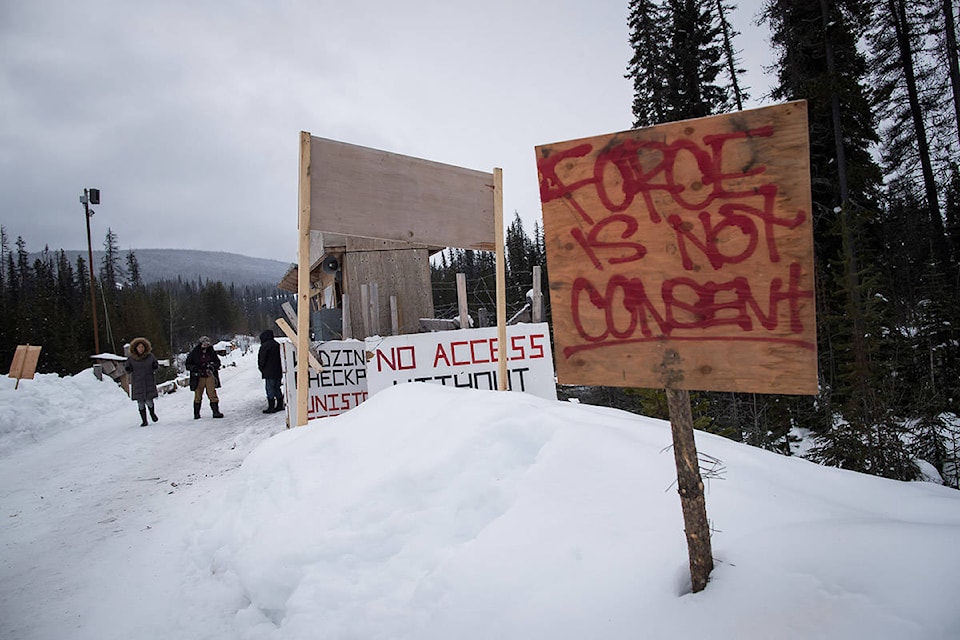By Matt Simmons, Local Journalism Initiative reporter, The Narwhal
Coastal GasLink has been forced to stop pipeline construction near protected wetlands after an inspection by the B.C. Environmental Assessment Office found the company cleared areas without completing the required surveying and planning.
Coastal GasLink was issued two non-compliance orders in June and now has to complete the surveys before the project can proceed in the affected areas.
The 670-kilometre pipeline is planned to transport natural gas from northeast B.C. to Kitimat, for shipment to markets in Asia.
Wet’suwet’en Hereditary Chiefs served Coastal GasLink with an eviction notice on Jan. 4, starting a chain of events that led to RCMP enforcing a court-ordered injunction to arrest more than 80 protesters in February, including elders, chiefs and matriarchs. On June 5, charges against 22 Wet’suwet’en members and supporters were dropped and many others were never charged.
The Unist’ot’en and Gidimt’en Clans brought two wetlands areas of concern to the attention of the Environmental Assessment Office this spring. When inspection officers investigated, they found construction had begun in these areas prior to proper surveying and planning.
The assessment office then inspected the remainder of the pipeline route and found the company’s wetlands management plan had not been followed in any of the wetlands along the route designated “ecologically and socioeconomically important,” according to a news release from the Unist’ot’en (Dark House), of Wet’suwet’en Nation, on Monday.
Coastal GasLink produced its own wetlands management plan “and cannot claim ignorance of the requirements laid out within it,” Unist’ot’en said.
As part of that plan, and under Coastal GasLink’s environmental assessment certificate, the company is required to conduct surveys of these ecologically sensitive areas prior to clearing and develop site-specific plans for mitigating any adverse effects caused by construction or clearing.
B.C.’s Ministry of Environment and Climate Change Strategy declined an interview request but said in a statement that 42 wetlands areas are affected. The Unist’ot’en release says there are nearly 300 protected wetlands along the pipeline route and Coastal GasLink hasn’t developed site-specific mitigation plans for any of them. It adds that nearly 80 per cent of the pipeline right of way has already been cleared, affecting most of these protected wetlands.
The assessment office issued two non-compliance orders — one on June 16 for not taking measures to limit the damage done to wetlands, and the other on June 22 for proceeding with work to clear the sites for construction prior to conducting the required surveys.
Coastal GasLink must now cease construction within 30 metres of wetlands areas designated as socio-economically important until construction preparation surveys are completed and an expert in wetlands conservation, on behalf of the company, has visited each site to identify options for minimizing the harm caused to the area during construction.
The orders are accompanied by another non-compliance order issued on June 16 due to workers’ lack of efforts to mitigate harm to whitebark pine, an endangered species in Canada. Last year, the company faced another order after initiating work prior to notifying trapline owners in the area around Houston.
READ MORE: RCMP patrol of smokehouse sparks concerns by Wet’suwet’en hereditary leader
Jason Slade, technical adviser to Unist’ot’en, says the Wet’suwet’en have been asking Coastal GasLink for months for site-specific plans regarding clearing and construction in wetlands.
The company said in a statement it does have a plan, but the assessment was not compliant with the plan.
Coastal GasLink said it is complying with the stop-work order for the identified sites.
“Environmental protection is a top priority for us,” spokesperson Suzanne Wilton told Black Press, adding that work has already begun under the enforcement orders to survey and report on the damage. She expects the company will be back in compliance by the end of July.
While Coastal GasLink completes its wetlands plans, work continues in other areas where work camps are being built and populated in preparation for laying the pipeline this summer. As of May 31, roughly 77 per cent of the route had been cleared and installation had started in Kitimat earlier this month. The company said it does not expect the stop-work order to have an overall impact on the project schedule.
Pipeline materials are stored in Houston, but Sleydo’ (Molly Wickham), a Gidimt’en spokesperson, says she hasn’t seen much work happening on Gidimt’en or Dark House territory. In Vanderhoof, about two hours away, it’s a different story. Construction on a 900-bed work camp is well underway.
In May, nine Wet’suwet’en hereditary chiefs signed a memorandum of understanding with the provincial and federal governments to work toward affirming Wet’suwet’en rights and title. But it doesn’t mean the hereditary chiefs have changed their stance on Coastal GasLink.
“We are still in opposition,” she says emphatically. “People should know that. The eviction order stands. And we’ll enforce that eviction order.”
READ MORE: Coastal GasLink will consult with health authorities before construction recommences
In a statement, the B.C. Ministry of Indigenous Relations and Reconciliation said the memorandum of understanding is a first step toward resolving “difficult and complicated issues” around Wet’suwet’en rights and title.
“By resolving these issues, we can avoid the kind of conflicts we’ve seen on the land, and work together for the benefit of all people who live in the region,” the statement said.
The ministry acknowledged that “at the time the MOU was reached, all parties at the table recognized that the differences relating to the Coastal GasLink project remain. That has not changed.”
With files from Thom Barker
